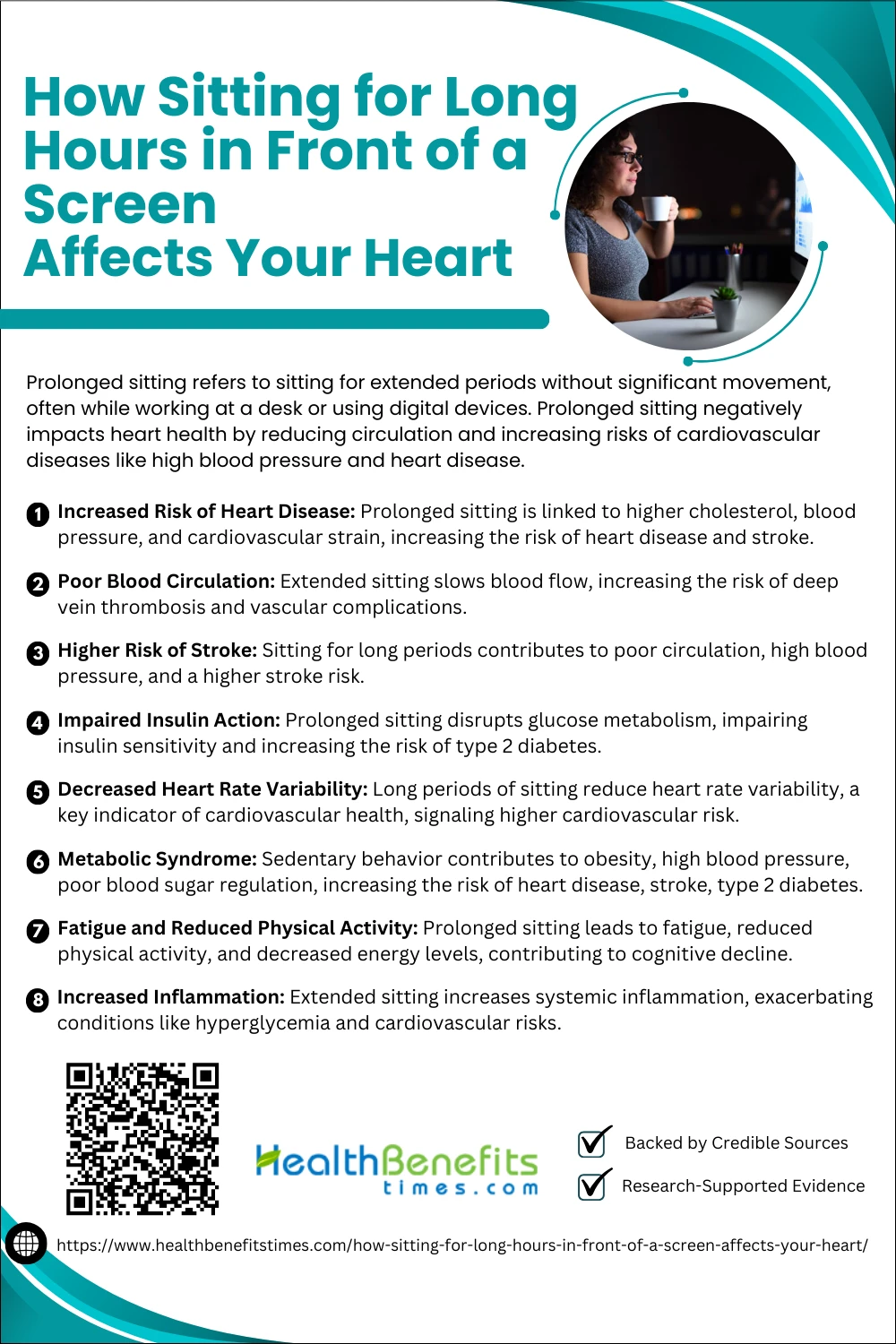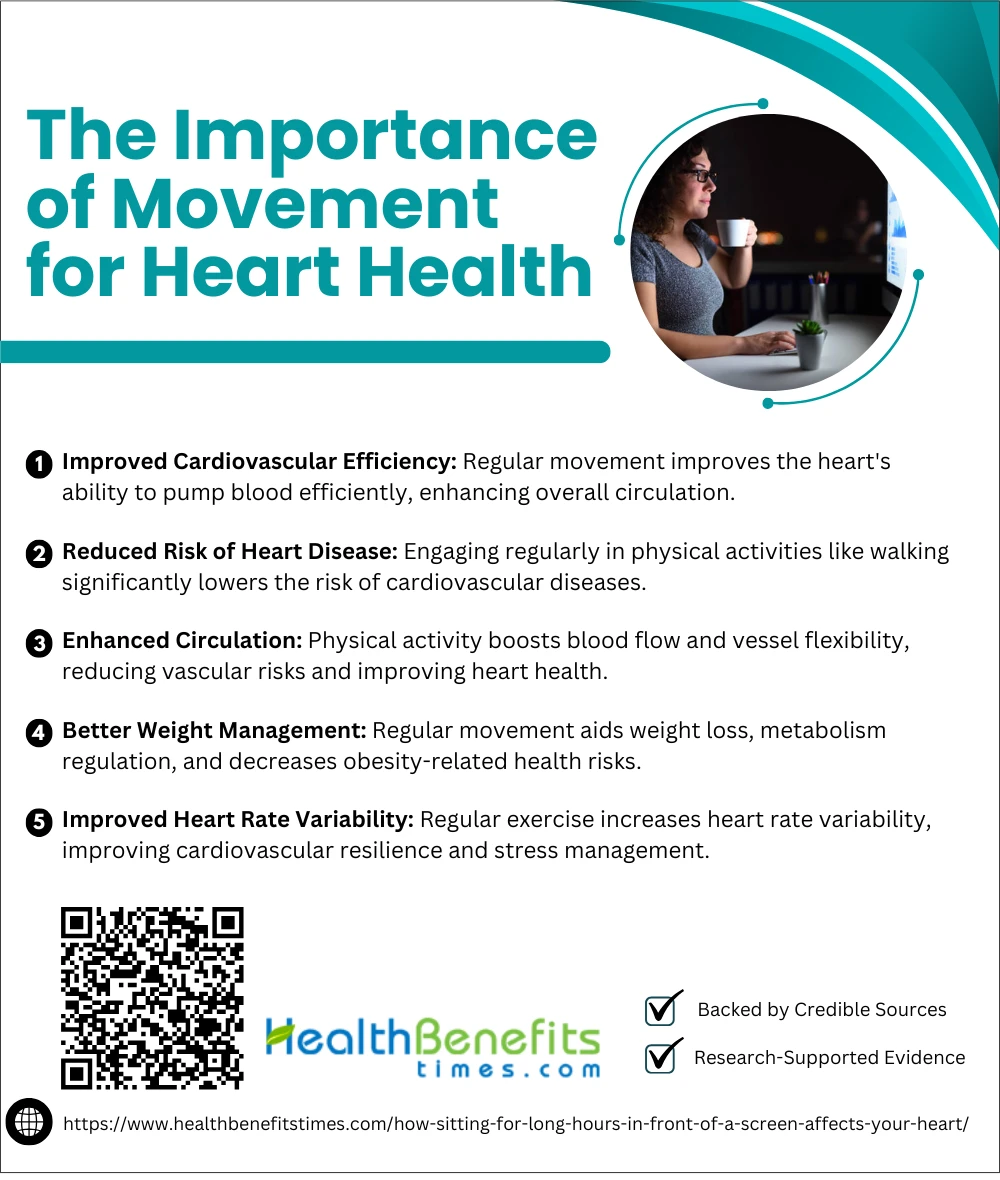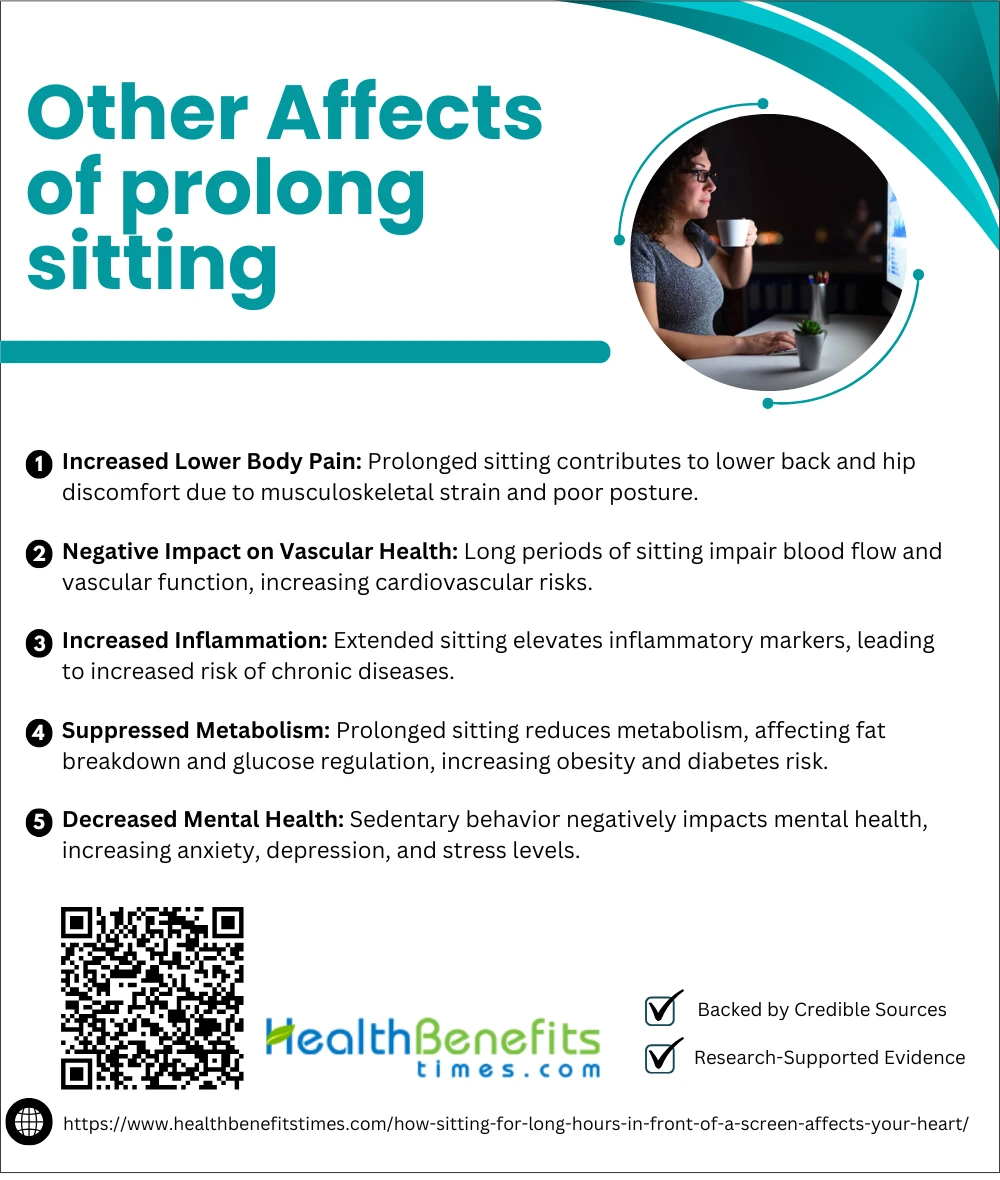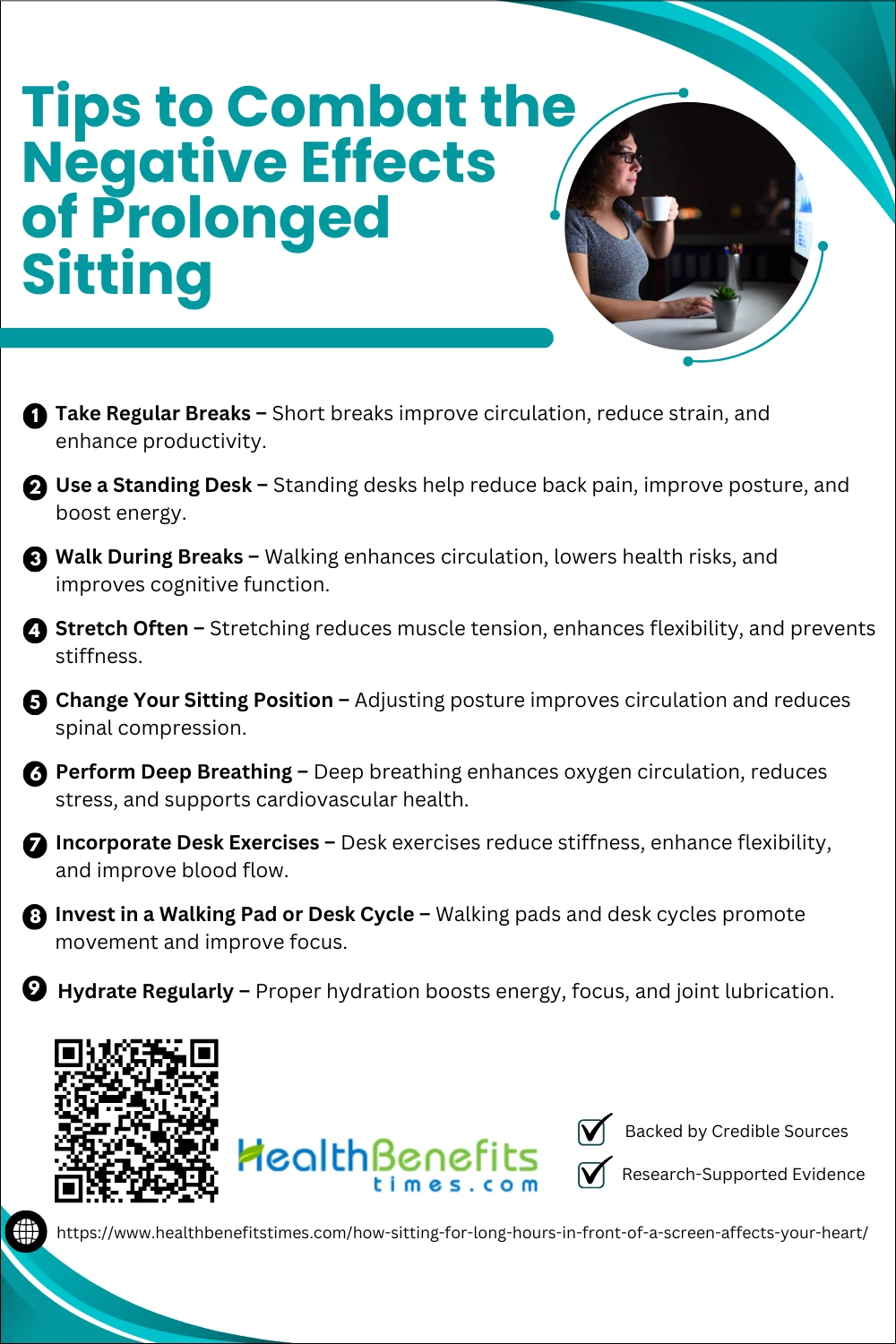- Prolonged sitting refers to sitting for extended periods without significant movement, often while working at a desk or using digital devices.
- Prolonged sitting negatively impacts heart health by reducing circulation and increasing risks of cardiovascular diseases like high blood pressure and heart disease.
- Regular movement, even small breaks, is crucial to counteract the harmful effects of sitting and maintain a healthy heart.
 Prolonged sitting refers to extended periods of inactivity where a person remains seated for hours without significant movement. It is commonly associated with desk jobs, screen use, and long commutes. Sitting for long hours in front of a screen has become an almost inevitable part of modern life, with many people spending significant portions of their day in front of computer monitors, phones, and TVs. While this may seem harmless at first, research reveals alarming effects on cardiovascular health. Studies have shown that prolonged sitting can increase the risk of heart disease and other related conditions, even for those who engage in regular physical exercise. A comprehensive study published by the American College of Sports Medicine emphasized that long sedentary periods negatively affect metabolic processes, including circulation, and may raise blood pressure and cholesterol levels, ultimately leading to heart-related issues. Furthermore, research has demonstrated that sedentary behavior, particularly when combined with screen time, can contribute to negative physiological changes such as reduced heart rate variability, which directly impacts heart health. To mitigate these risks, experts recommend incorporating frequent breaks and posture adjustments, emphasizing the importance of reducing the time spent sitting for better cardiovascular outcomes.
Prolonged sitting refers to extended periods of inactivity where a person remains seated for hours without significant movement. It is commonly associated with desk jobs, screen use, and long commutes. Sitting for long hours in front of a screen has become an almost inevitable part of modern life, with many people spending significant portions of their day in front of computer monitors, phones, and TVs. While this may seem harmless at first, research reveals alarming effects on cardiovascular health. Studies have shown that prolonged sitting can increase the risk of heart disease and other related conditions, even for those who engage in regular physical exercise. A comprehensive study published by the American College of Sports Medicine emphasized that long sedentary periods negatively affect metabolic processes, including circulation, and may raise blood pressure and cholesterol levels, ultimately leading to heart-related issues. Furthermore, research has demonstrated that sedentary behavior, particularly when combined with screen time, can contribute to negative physiological changes such as reduced heart rate variability, which directly impacts heart health. To mitigate these risks, experts recommend incorporating frequent breaks and posture adjustments, emphasizing the importance of reducing the time spent sitting for better cardiovascular outcomes.
The Link between Sedentary Behavior and Heart Health
Sedentary behavior refers to any activity that involves little to no physical movement, especially activities where an individual is sitting for extended periods of time. This behavior is most common during desk jobs, watching TV, or excessive screen use. Research indicates that prolonged sitting can lead to various health complications, particularly related to heart health. (1)
Link Between Sitting and Cardiovascular Diseases
Numerous studies have shown a strong correlation between sedentary behavior and an increased risk of cardiovascular diseases. According to a study published in the Journal of the American College of Cardiology, sedentary behavior is linked to higher incidences of heart disease, stroke, and increased cardiovascular mortality. This is especially true when combined with insufficient physical activity levels (JACC).
Impact of Inactivity on Heart Health
The negative effects of prolonged inactivity on heart health are profound. Inactivity leads to poor circulation, increased blood pressure, and higher cholesterol levels, which strain the heart over time. Additionally, sedentary behavior has been found to impair vascular function, further increasing the risk of heart disease and other cardiovascular issues. (2) Therefore, reducing sedentary time and increasing physical activity are essential steps to improve heart health and reduce cardiovascular risks.
How prolong Sitting Affects Heart Health
Prolonged sitting has become a common part of modern life, but its impact on heart health is concerning. Extended periods of inactivity can lead to serious cardiovascular issues, affecting circulation and overall heart function.
 1. Increased Risk of Heart Disease
1. Increased Risk of Heart Disease
Prolonged sitting is closely linked to an elevated risk of cardiovascular disease (CVD). Research indicates that extended periods of sitting can contribute to increased cholesterol, blood pressure, and overall strain on the cardiovascular system, which ultimately raises the risk of heart disease and stroke. Studies highlight that even individuals who exercise regularly are still at increased risk if they remain sedentary for long periods. One study found that prolonged sitting led to increased mortality rates, independent of physical activity levels. (3) Another study linked excessive sitting to heightened cardiovascular disease mortality. (4) Additionally, a review emphasized the direct relationship between prolonged sitting and coronary heart disease. (5)
2. Poor Blood Circulation
Prolonged sitting impairs blood circulation, leading to a range of vascular issues. Sitting for long periods causes the blood flow to slow, particularly in the lower limbs, which can result in increased risk for deep vein thrombosis (DVT) and other circulatory problems. Studies have shown that blood flow in the legs decreases with prolonged sitting, impairing vascular function and increasing the risk of clot formation. One study found that even short periods of sitting could significantly reduce blood circulation in the legs. (6) Another research on sitting showed a decrease in peripheral and central vascular health due to reduced blood flow. (7) Furthermore, one study also revealed that prolonged sitting affected the microvascular function, particularly in the lower extremities, leading to impaired circulation and increased risk for vascular complications. (8)
3. Higher Risk of Stroke
Prolonged sitting has been associated with an increased risk of stroke, with research suggesting that a sedentary lifestyle can impair vascular health and lead to conditions that increase stroke risk. Studies have shown that uninterrupted sitting contributes to poor circulation, higher blood pressure, and decreased blood flow, which are significant risk factors for stroke. One study highlighted that sedentary behavior was linked to higher stroke mortality. (9) Furthermore, research indicated that breaking up prolonged sitting could reduce stroke risk factors, improving overall cardiovascular health. (10)
4. Impaired Insulin Action
Prolonged sitting can lead to impaired insulin sensitivity, contributing to the development of insulin resistance and metabolic disorders. Research indicates that sitting for extended periods disrupts glucose metabolism, making it harder for the body to regulate blood sugar. This can contribute to conditions like type 2 diabetes. Studies have found that even when sitting is interrupted with light activity, insulin sensitivity improves significantly. (11) One study found that regular breaks from sitting led to better postprandial glucose control, highlighting the importance of reducing sedentary time to maintain metabolic health. (12)
5. Decreased Heart Rate Variability
Prolonged sitting has been shown to negatively affect heart rate variability (HRV), a key indicator of cardiovascular health. Studies have found that long sedentary periods lead to reduced HRV, which is associated with higher cardiovascular risk. One study observed that sitting for extended periods decreases HRV, signaling a negative effect on heart autonomic regulation (MDPI). Other research also linked long sitting times with decreased HRV, suggesting that breaking up sedentary periods may improve heart health. (13)
6. Metabolic Syndrome
Prolonged sitting is a major contributor to metabolic syndrome, a cluster of conditions that increase the risk of heart disease, stroke, and type 2 diabetes. Studies have shown that long periods of sedentary behavior are associated with obesity, high blood pressure, and poor blood sugar regulation. One study found a strong correlation between sitting time and metabolic dysfunction, emphasizing the importance of reducing sedentary behavior to mitigate these risks. (14) Similarly, another study highlighted the impact of prolonged sitting on metabolic syndrome risk factors, underscoring the need for physical activity breaks. (15)
7. Fatigue and Reduced Physical Activity
Prolonged sitting, especially in sedentary lifestyles, has been linked to fatigue and a reduction in physical activity levels. Studies show that long periods of sitting can lead to decreased hip extension, contributing to lower physical activity levels ScienceDirect. (16) Moreover, breaking up sitting with walking breaks has been shown to reduce fatigue BMJ Open. Additionally, such sedentary behavior is also associated with cognitive decline due to the lack of movement, which increases fatigue JSTAGE. One study showed that sedentary workers are more likely to experience significant energy declines throughout their workday, while another suggests that proper interventions could mitigate this Springer. (17) (18)
8. Increased Inflammation
Prolonged sitting has been shown to increase systemic inflammation. Research highlights that long, uninterrupted sitting leads to an increase in pro-inflammatory cytokines. (19) In particular, sitting-induced inflammation has been shown to exacerbate conditions like hyperglycemia and autonomic instability. (20) Interrupting prolonged sitting with physical activity may help reduce this inflammation. (21) Research also emphasizes how sedentary behaviors contribute to inflammatory biomarkers linked to cardiovascular risks. (22) Additionally, inflammation can be exacerbated by prolonged sitting without proper breaks. (23)
Other Affects of prolong sitting
Prolonged sitting not only affects heart health but also contributes to a range of other health issues. These include poor posture, muscle stiffness, weight gain, and increased risks of diabetes and anxiety.
Prolonged sitting is known to cause significant discomfort, especially in the lower body regions such as the back and hips. Studies have shown that sitting for extended periods increases the risk of developing musculoskeletal pain, with a notable association between sitting time and lower body discomfort Pakistan Armed Forces Medical Journal. (24) Sitting for long hours also disrupts proper posture, contributing to the aggravation of back pain Academia. (25) Moreover, lower back pain has been linked to sedentary behaviors, especially when combined with poor sitting posture. (26)
2. Negative Impact on Vascular Health
Prolonged sitting can have detrimental effects on vascular health, especially with regard to blood flow and endothelial function. Research has shown that sitting for long periods impairs vascular function, leading to increased risk of cardiovascular diseases. (27) The lack of movement during prolonged sitting negatively affects peripheral circulation, which can lead to vascular dysfunction. (28) Additionally, studies have indicated that even short breaks from sitting may help mitigate some of the harmful effects on vascular health. (29)
3. Increased Inflammation
Prolonged sitting has been associated with an increase in inflammatory markers, contributing to health risks like cardiovascular diseases. Studies indicate that prolonged sitting increases the levels of pro-inflammatory cytokines such as IL-6, leading to systemic inflammation. (21) This inflammation is exacerbated by sedentary behaviors, contributing to chronic health conditions. (30) Interrupting long sitting periods with physical activity can help reduce inflammation and improve health outcomes. (23)
4. Suppressed Metabolism
Prolonged sitting can suppress metabolism, negatively impacting glucose and lipid metabolism. Research suggests that sitting for long periods reduces lipoprotein lipase (LPL) activity, impairing fat breakdown and increasing the risk of metabolic disorders. (31) Moreover, breaking up sitting time with activity can improve metabolic responses, such as reducing postprandial glucose levels. (32) This metabolic suppression is linked to obesity and type 2 diabetes, underlining the importance of reducing sedentary behavior Diabetes Journals.
5. Decreased Mental Health
Prolonged sitting has a significant negative impact on mental health. Studies suggest that extended sedentary behavior is associated with increased symptoms of anxiety and depression. (6) Sitting for long periods without breaks can lead to negative mood alterations and higher stress levels. (33) Furthermore, workplace studies indicate that excessive sitting exacerbates mental health challenges, especially in young people. (34)
The Importance of Movement for Heart Health
Regular movement is essential for maintaining a healthy heart. Simple activities like walking, stretching, and standing up periodically can boost circulation, reduce heart disease risk, and improve overall cardiovascular health.
 1. Improved Cardiovascular Efficiency
1. Improved Cardiovascular Efficiency
Regular physical movement is crucial in improving cardiovascular efficiency. Studies have shown that aerobic exercises, such as running and walking, enhance the heart’s ability to pump blood more efficiently, promoting better circulation. (35) Additionally, endurance training significantly improves lipid oxidation and heart function. (36) For heart patients, even activities like walking can restore mechanical efficiency, enhancing overall cardiovascular health. (37)
2. Reduced Risk of Heart Disease
Engaging in regular physical activity significantly reduces the risk of heart disease. Studies indicate that increased movement, especially walking, is associated with a lower incidence of cardiovascular disease. (38) Additionally, research highlights that maintaining a more active lifestyle can lower heart disease hospitalization rates. (39) A meta-analysis also concluded that higher physical activity levels correlate with a reduced risk of coronary heart disease. (40)
3. Enhanced Circulation
Engaging in physical movement enhances circulation by promoting better blood flow and oxygen distribution throughout the body. Studies show that physical activity, such as walking and exercise, helps improve vascular function and circulation, especially in individuals with conditions like diabetes. (41) Regular movement also increases blood vessel flexibility and reduces the risk of blood clots. (42) This improvement in circulation supports overall cardiovascular health. (43)
4. Better Weight Management
Regular physical activity is essential for weight management, as it helps burn calories, regulate metabolism, and build lean muscle. Studies confirm that consistent movement, such as walking or exercising, increases energy expenditure, which is crucial for weight loss and maintaining a healthy weight. (44) Additionally, movement reduces visceral fat, which is a key contributor to obesity-related diseases. (45) Engaging in physical activities also improves metabolic health, aiding long-term weight control. (46)
5. Improved Heart Rate Variability
Regular movement, such as physical activity and exercise, has been shown to enhance heart rate variability (HRV), which is a key indicator of heart health. Studies indicate that movement, especially aerobic exercises, improves HRV by increasing parasympathetic activity, which supports a more adaptable heart rate. (47) Additionally, movement can lead to a more consistent heart rate, contributing to improved cardiovascular resilience. (48) Increased HRV from physical activity is linked to lower risks of cardiovascular diseases and better stress management. (49)
Tips to Combat the Negative Effects of Prolonged Sitting
Combatting the negative effects of prolonged sitting is essential for overall health. Simple changes like taking frequent breaks, improving posture, and incorporating light exercises can significantly reduce health risks associated with inactivity.
Regular breaks from prolonged sitting can significantly reduce health risks such as cardiovascular disease and metabolic disorders. Studies show that short breaks improve circulation and decrease musculoskeletal strain. Furthermore, taking movement breaks enhances productivity and mental well-being. (50) Implementing reminders to stand and stretch at work can lower the risk of chronic diseases. (51)
2. Use a Standing Desk
Using a standing desk helps reduce back pain and improve posture, making it a viable alternative to prolonged sitting. (52) Research also highlights the benefits of alternating between sitting and standing to maintain musculoskeletal health. (53) Additionally, standing desks can boost energy levels and productivity, mitigating fatigue associated with sedentary work.
3. Walk During Breaks
Taking short walks during breaks can enhance cardiovascular health and reduce the risks associated with prolonged sitting. Studies indicate that walking every 30 minutes improves circulation and lowers metabolic markers of sedentary behavior. (54) Walking breaks also improve cognitive function and workplace productivity. (55) Additionally, incorporating brief walks helps mitigate lower back pain and stiffness. (56)
4. Stretch Often
Frequent stretching alleviates muscle tension and enhances flexibility, reducing the adverse effects of prolonged sitting. Research suggests that stretching improves blood flow and prevents musculoskeletal disorders. (56) Additionally, targeted stretching can prevent spinal stiffness and promote postural stability. (57) Neurological studies also show that stretching routines may counteract nerve compression due to extended sitting. (58)
5. Change Your Sitting Position
Frequent changes in sitting posture can mitigate the adverse effects of prolonged sitting by enhancing circulation and reducing spinal compression. Research suggests that alternating between upright and reclined positions can lower lower-back strain and improve comfort. (59) Additionally, studies indicate that incorporating micro-movements, such as shifting weight and adjusting posture, can help prevent musculoskeletal disorders. (56) Wearable posture-monitoring devices also provide real-time feedback to encourage healthier sitting habits. (60)
6. Hydrate Regularly
Prolonged sitting can lead to dehydration, reducing cognitive function and increasing fatigue. Regular hydration improves circulation and helps maintain energy levels source. Studies indicate that even mild dehydration impairs focus and productivity. (61) Proper fluid intake also supports joint lubrication, reducing discomfort from extended sitting source.
7. Incorporate Desk Exercises
Incorporating desk exercises into your routine can significantly reduce the adverse effects of prolonged sitting, such as muscle stiffness and reduced circulation. Studies highlight that stretching and movement breaks enhance flexibility and reduce discomfort associated with sedentary behavior. (62) Additionally, simple movements like seated leg lifts and chair squats can improve blood flow and lower the risk of metabolic disorders. (62) Engaging in short, frequent exercise breaks can also enhance productivity and cognitive function. (62)
8. Invest in a Walking Pad or Desk Cycle
Using a walking pad or desk cycle while working can counteract the harmful effects of prolonged sitting by promoting movement and increasing daily energy expenditure. Research suggests that walking pads help maintain cardiovascular health and reduce sedentary time. (62) Additionally, studies show that a desk cycle can enhance leg muscle engagement and support weight management. (62) Regular use of these devices improves focus and work performance, making them effective solutions for office workers. (62)
9. Perform Deep Breathing
Deep breathing exercises help counteract the adverse effects of prolonged sitting by improving oxygen circulation and reducing stress. Studies indicate that diaphragmatic breathing can enhance lung function and lower cortisol levels. (63) Additionally, controlled breathing techniques support autonomic nervous system balance, mitigating sedentary-induced fatigue. (64) Research further confirms that regular deep breathing can enhance cardiovascular health, reducing the risk of sitting-related complications.
Conclusion
In conclusion, sitting for long hours in front of a screen can have significant consequences for heart health, contributing to poor circulation, high blood pressure, and increased risk of cardiovascular diseases. The sedentary lifestyle often associated with extended screen time disrupts metabolism and negatively affects heart function. However, the good news is that incorporating regular movement, such as taking breaks, stretching, and staying active throughout the day, can help mitigate these risks. By making small changes in daily routines, we can protect our heart health and prevent long-term damage caused by prolonged sitting. Staying mindful of movement is key to overall well-being.




